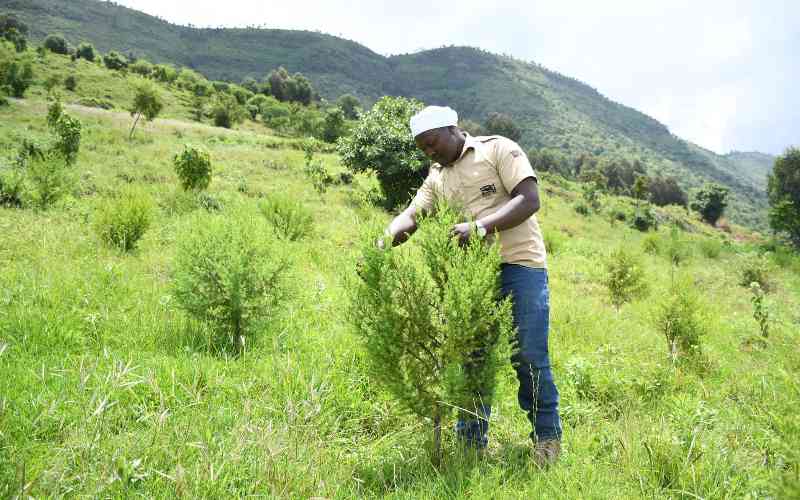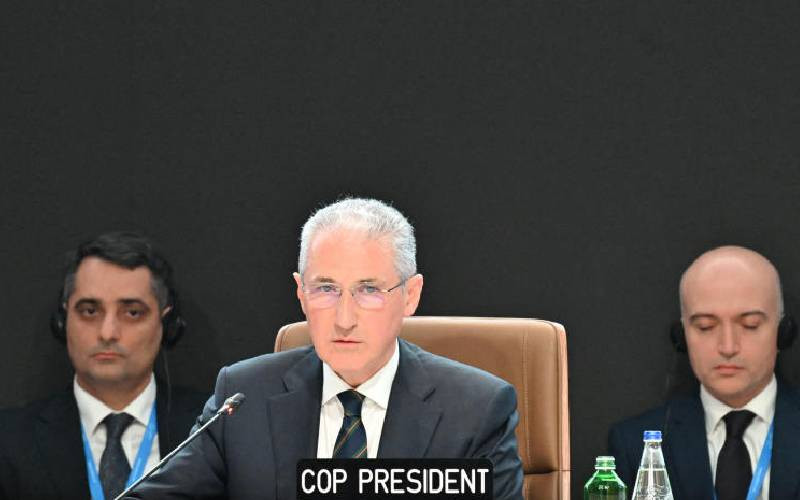Lorem ipsum dolor sit amet adipisicing elit. Sapiente fuga nisi rerum iusto intro.
Lorem ipsum dolor sit amet adipisicing elit. Sapiente fuga nisi rerum iusto intro.


Reuben Mwangi strides with purpose through the rugged slopes of the Sophia section in Aberdare Forest.
His gaze is steady as he inspects the rows of Rosewood seedlings, also known by its scientific name hagenia abyssinica, thriving in the once-barren landscape.
What was once stripped bare by illegal loggers and charcoal burners is now coming back to life with the native cedar, rosewood, podo, and olive trees swaying gently in the mountain breeze, a whisper of nature reclaiming its territory.
The Sophia section, which falls under Geta Forest Station, is part of the larger Aberdare ecosystem, and for years it suffered the brunt of illegal charcoal burning, wood harvesting, and encroachment.
“These seedlings are about seven months old, and they’re flourishing, we planted the exact species that originally belonged here, the very ones destroyed by illegal activities. It’s a long journey, but the forest is healing,” said Mwangi, a field officer with Rhino Ark Charitable Trust.
Left outside the protection of the world’s longest conservation fence, a towering seven-foot barrier that encloses over 2,000 square kilometres of the Aberdares ecosystem, the area became a vulnerable target. This omission occurred when the electric fence, completed in 2009 for Sh 800 million, was thought to be unnecessary for the steep, rugged terrain.

“Back then, they assumed this part wasn’t easily accessible, but it was. Over time, illegal activities almost completely devastated the area, but thanks to efforts by Rhino Ark, the Darwin Initiative, and the Kenya Forest Service, we are reclaiming it,” he explained.
In addition, there’s a special emphasis on reviving the native bamboo species, with a dedicated greenhouse set up to propagate bamboo a species that flourishes in the high-altitude, water-catchment zones of the Aberdare Ranges.
"Bamboo is vital for water conservation, and we're focusing on areas that need it most. This species belongs here, and we’re essentially replanting it in degraded areas where it once thrived. By the end of 2024, we aim to fully rehabilitate the targeted areas of the Sophia section," he added.

Alongside these efforts, sustainable community programs have been launched to promote conservation. The community now plays a crucial role through the formation of Community Forest Associations (CFAs), such as the Geta Forest CFA, which has been instrumental in collaborating with the Kenya Forest Service.
“We have taken ownership of the forest,” said Daniel Mwaura, chairman of the Geta CFA.
He added that the identification cards are essential for effective forest management by the Kenya Forest Service. If any member is found participating in illegal activities within the forest, their card will be revoked, and legal action will be taken against them.
These initiatives not only focus on conservation but also provide job opportunities for many in the area, allowing them to participate in planting, weeding, and various other casual jobs.

Nearby, a group of at least ten youths works tirelessly erecting posts for the new solar-powered electric fence. This new barrier, part of the Wanjohi -Shamata Electric Fence Project, aims to physically separate the forest from the neighbouring communities.
“This project runs at a stretch of about 10 to 12 kilometres it ends at the mouth of Malewa River, Since February this year we have completed about 7.9 kilometers,” Peter Tabatia, an electric fence technician leading the team, shares their progress
Among the team is 24-year-old Miriam Wanjiku, the only woman in the group.
"This place was destroyed. People had cut down the trees for charcoal and posts. But now, with the fence and ongoing conservation efforts, I’m hopeful that the rivers, like the one up there that dried up, will soon flow again. This area was once home to wildlife like gazelles and antelopes, and I believe they will return," she said.

From afar, the newly erected fence slices through a dense plantation of eucalyptus trees, visibly splitting a private farm into two sections.
According to Peter Kiana, the Kenya Forest Service Inspector in charge of enforcement at Geta Forest, the farm owner had encroached far into the forest, expanding his land and planting the eucalyptus. However, with the new fence in place, a distinct boundary has been established, sharply defining the separation between the protected forest and the surrounding community land.
“This place used to have rampant fires, cedar poaching, and even wildlife poaching, Illegal encroachment was a big issue too, with people extending their farms into the forest. But since the fence was erected and we started educating the community, we’ve seen crime almost completely to zero cases,” says Inspector Peter Kiana.

A vital part of the recovery is the Indigenous tree nursery established by Rhino Ark through the Darwin Initiative. The nursery, with a capacity for 100,000 trees, currently holds 82,350 seedlings at Geta Tree Nursery. This nursery has been critical for rehabilitating the Sophia section.
The association has started its tree nurseries, providing seedlings to community members for planting in their homes. This has reduced pressure on the forest, with over 5,000 seedlings currently in their nursery.
The joint efforts of the community and key stakeholders are essential in the mission to protect this fragile ecosystem, one of Kenya’s vital water towers. As a critical water catchment area, it supports major rivers such as the Malewa and Tana, and feeds reservoirs like the Ndakaini Dam, which supplies water to Nairobi and its surrounding areas.

The forest is not only a lifeline for water but also a haven for diverse wildlife, including the critically endangered Mountain Bongo, one of the world's rarest antelopes. With fewer than 100 individuals remaining in the wild, the majority of this species is found in the Aberdare Forest.
“These conservation efforts are in line with the government’s ambitious target of planting 15 billion trees by 2032, a plan designed to boost biodiversity and secure water resources for future generations,”, said Adams Mwangi the Fence and Community Manager at Rhino Ark.


To personalise content, tailor ads and provide best user experience, we use cookies. By using our site, you agree to use our cookies. Privacy Policy
Subscribe to our newsletter and stay updated on the latest developments and special offers!


